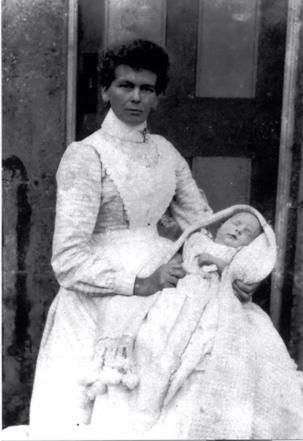Midwife in Teynham 100 Years Ago

Grandma Cork as a Midwife in 1908
holding an unknown child.
It is early morning of the 20 June 1908 – the place Station Row, Teynham. The rain is falling steadily from an overcast sky. A small boy, cap askew and panting and puffing, can be seen urgently knocking on the front door of No. 4. After a short while the door is thrown open by a tall lady in her late forties. She is smartly dressed in an immaculate nurses uniform covered by a pinafore. She holds a hurried discussion with the boy and returns indoors. Within a few minutes, in response to the small lad’s urgings, the lady mounts her rather ancient bicycle and proceeds to pedal furiously in the direction of Barrow Green; the young lad running alongside trying to keep up whilst carrying her heavy medical bag. The midwife is anxious to reach his mother, Mrs Gilbert, a 34 year old housewife who is about to give birth to her sixth child. The time is now 8.30 a.m. The lad, his errand run, collects his metal hoop and iron stick from the garden shed and dashes off down the hill to find his pals prior to going to school over the hill. Later in the morning, having successfully delivered a perfectly formed baby boy, with no complications and no doctor in attendance, the midwife takes time to enter all the details of the birth in her “Midwife’s Record Book”. Information of this birth and many other confinements attended will eventually be presented to the area Health Authorities for registration purposes. Having made sure that the baby and mother are comfortable and settled and having left instructions for Mr Gilbert to follow, the midwife refers to her daily worksheet to see who her next patient is and prepares to cycle off.
This scenario could be typical of many such occasions when the services of a midwife were called upon in those far off days in and around Teynham. Details of such events have been taken from my Grandmother’s “Record Book”, a copy of which has only recently been sent to me by my cousin in Canada. The book shows the many confinements attended by her during the years 1908 and 1909 whilst she lived here in Teynham and later in Sittingbourne. All this information was hitherto unknown to me as I was not aware of her activities living in Teynham. At the time she was living “over the line” in Station Row Cottages with her husband and family of 8 children, the fifth in line being my father, Grandmother was a qualified midwife and attended patients as far afield as Doddington, Sittingbourne, Milton and Bapchild. One must appreciate that visiting expectant women in those days, and at those distances, was no mean feat considering that her only means of transport was her bicycle. Many such visits would have occurred during the hours of darkness, and as many minor roads were unmade at the time, these journeys must have been extremely uncomfortable, especially as her only means of lighting came from the carbide lamp perched precariously on the front of her bicycle and the small gas lamps dimly shadowing the streets. Many of the names recorded are still around in the area today, surnames such as Everard, Smith, Heathfield, Sidders and Baker. Grandmother lived a hectic life here in Teynham, being on call 24 hours a day, 7 days a week.
Early in 1909 Grandmother decided to move to Sittingbourne where she carried on her profession from 46 Shakespeare Road. From there she attended confinements in the districts of Borden, Iwade and Milton. Later, as times became more difficult prior to the First World War, she decided to seek a better life in Canada, and emigrated in the latter part of 1909, taking 6 of her family with her to settle in Toronto, Ontario. My father and his older sister remained to live in Teynham Lane. The move to Canada was made possible with the assistance of the Salvation Army, of which Association the family were staunch members. My Grandmother continued to act as midwife in and around the district of Toronto, finally dying in 1942 at the age of 84. I still like to think that there must be descendants of the many babies she brought into the world at that time living around Teynham today.
In conclusion it is interesting to note the “Rules Regarding Cleanliness and Disinfection” printed in her record book for all midwives to follow. Reading through them it would appear that they were as stringent if not more so, than those in operation some 100 years later.
The book itself contains exact details, written in her own hand, of each birth, such as the mother’s name, address, age, number of existing children, hours in labour and sex of newborn, together with condition of baby at birth. Records from this book throw light on the living conditions here in Teynham 100 years ago, together with a midwife’s service available to the residents at that time.
Bernard Cork